Since exploration began in August 2017 at its Soledad copper-gold-silver project in Peru, Chakana Copper (TSXV: PERU; US-OTC: CHKKF) has drilled four of 17 confirmed breccia pipes, pinpointed another 12 targets, and tripled its land position in the district to 31 square kilometres.
The company drilled 25,200 metres in 94 holes in its first round of exploration at the project, 260 km northwest of Lima, and 35 km south of Barrick Gold’s Pierina gold mine, and plans to drill another 20,000 metres this year, after it gets a permit (the approval of which is imminent, management says) that will allow it to drill from 120 drill pads.
“We’ve only scratched the surface,” says David Kelley, the company’s president and CEO. “Because of the limitation of the original drill permit, we were only able to drill four of the breccia pipes, but with the next permit, we can test all the targets in the northern part of the property — everything from the bottom of the valley to the north — which is the majority of the known breccia pipes.”
Despite the limitations of its existing permit, Chakana Copper has reported drill results from three of the four breccia pipes tested — Bx1, Bx5 and Bx6 — all of which contain pervasive mineralization and are vertically extensive, Kelley says.
Bx1 has been drilled down to 490 metres’ depth, and remains open. Highlights include hole 17-18, which returned 209 metres from surface of 1% copper, 2.22 grams gold per tonne and 70 grams silver per tonne, for a 3% copper-equivalent grade.
Hole 18-59 intersected 233 metres from surface of 0.85% copper, 1.4 grams gold and 57 grams silver for a 2.24% copper equivalent, and hole 18-77 cut 244 metres from surface of 0.91% copper, 1.4 grams gold and 56 grams silver for a 2.3% copper-equivalent grade.
Chakana also found a blind breccia body 40 metres north of Bx1. Unlike the Bx1 pipe, which outcrops, the top of the blind pipe is 125 metres below surface. It’s possible that the two pipes coalesce at depth.
“The real significance of the blind breccia pipe is that it tells us some of the pipes are exposed, but not all of them. So when I say we have 17 confirmed breccia pipes at surface, we think we have at least a dozen [more], because we have strongly altered areas where we don’t see the breccia is at surface. If you find one, what are the chances you’re going to find more?”
Kelley says there are likely more blind pipes, and that it’s not uncommon for tourmaline breccia clusters to contain as many as 100 pipes.
The main Bx1 pipe also has very high-margin grades, Kelley says, noting that typically tourmaline breccia bodies contain the highest grades at the margins, where breccia textures have higher permeability, due to the alignment of tabular breccia clasts, which form a shingle breccia texture.

Chakana Copper’s project team at the Soledad copper-gold-silver project in the western ranges of the Andes in Peru in 2017. From left: Carlos Montoya, project manager; Steve Park, chief consulting geologist; Favio Medrano, field assistant; David Kelley, CEO; and Victor Torres, project geologist. Credit: Chakana Copper.
The Bx5 pipe, 1 km northwest of Bx1, is not as high grade, Kelley says, but it’s still “very good”. Drill hole 17-41 returned 164 metres of 0.51% copper, 1.7 grams gold and 27.4 grams silver for a 2.8% copper-equivalent grade, starting from 12 metres below surface. Hole 18-80 cut 264 metres from surface of 0.71% copper 1.3 grams gold and 24.3 gram silver for 2.7% copper equivalent.
Results from Bx6, 500 metres north of Bx5 and 1,000 metres northwest of Bx1, and traced down to 800 metres’ depth, include 18-103, which intersected 29 metres of 0.76% copper, 1.2 grams gold and 227.7 grams silver for 3.52% copper-equivalent starting from 64 metres downhole, and 18-107, which returned 14 metres of 1.92% copper, 3.8 grams gold and 13 grams silver for a copper-equivalent grade of 4.54%, starting from 86 metres downhole.
Bx6 is the northernmost and highest elevation outcropping breccia body found to date. The northern margin of the pipe remains undrilled and requires 2,500 metres of drilling to confirm the pipe’s geometry and grade distribution.
The fourth and largest pipe drilled — Bx3E, which sits between Bx1 and Bx5 — had good intercepts, but lacks long mineralization runs that Kelley has seen in the other three pipes. “We’re not sure why — it’s possible that the pipe formed late in the mineralizing event, and it was the last gasp of brecciation, and the fluids were exhausted at that point,” he says. “Or if it was formed early, before the hydrothermal fluids developed to the point that they invaded the breccia. There are so many things we don’t know about the deposit, and that’s one of them.”
Looking ahead to its 2019 drill program, which starts in May, Kelley says the company has over 60 targets to explore based on a surface exploration program consisting of detailed mapping of rocks and alteration, rock and soil sampling, and time-domain electromagnetic surveys around each of the breccia targets.
Chakana is earning a 100% stake in the northern part of the project over four and a half years from Condor Resources (TSXV: CN). The original agreement included a 2% net smelter return royalty for Condor, but Chakana recently repurchased half of it. The $565,000 cost consisted of US$275,000 in cash and 900,000 Chakana shares, or a steep discount to the US$2-million price in the original option agreement.
“By doing it now, we were able to acquire the royalty at a 70% discount to what we would have had to pay for it later,” Kelley says. “And if we exercise the option agreement, we can purchase an additional 0.5%, so we can take that royalty to half a percent on the Condor ground.”
“A reduced royalty burden can have a huge impact on the economics for a project,” Kelley says. “The driving force was our confidence in the project. We believe in this project, and for us to do this deal now makes sense, because we do see it advancing and thought it was a good strategic move to acquire it now.”

Chakana Copper CEO David Kelley (left) and chairman Douglas Kirwin outside the Royal Ontario Museum in Toronto, where some of Kirwin’s mineral and ore collection is on display. Photo by Trish Saywell.
Before setting up Chakana in December 2016, with co-founders Tom Wharton and Juan Valdivia, Kelley was general manager of exploration for MMG and was responsible for developing the exploration program at Las Bambas. He was a member of the joint discovery team of the Zuun Mod molybdenum-copper discovery in Mongolia, the Wayamaga gold deposit in French Guiana and the High Lake East deposit in Nunavut.
The company’s chairman is Douglas Kirwin, a member of the joint discovery team of the Hugo Dummett deposit at Oyu Tolgoi in Mongolia. Another geologist on the board is John Black, CEO of Regulus Resources and Aldebaran Resources.
Chakana’s shares are trading at 39¢ in a 52-week range of 25¢ to 93¢. The company has a $31-million market capitalization.

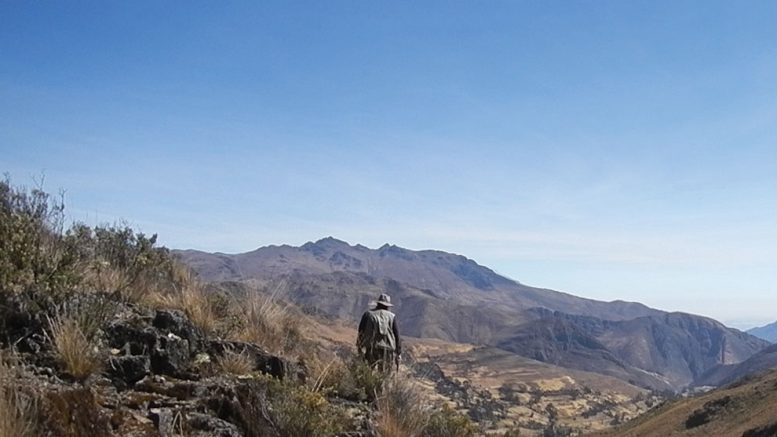
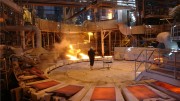
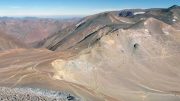
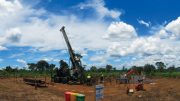
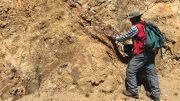
Be the first to comment on "Chakana Copper advances Soledad in Peru"